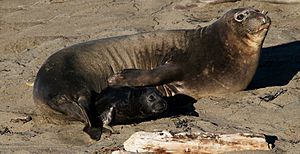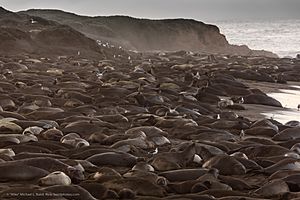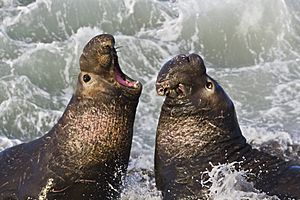Piedras Blancas State Marine Reserve and Marine Conservation Area facts for kids

Piedras Blancas State Marine Reserve (SMR) and Piedras Blancas State Marine Conservation Area (SMCA) are two important ocean areas. They are located near the coast of San Luis Obispo County in central California. These areas are like underwater parks. They work together to protect the amazing marine life found there. The total size of these protected areas is about 19.68 square miles (51 square kilometers).
In the State Marine Reserve (SMR), it is against the rules to fish or take any living things from the ocean. This means all marine life is completely safe. In the State Marine Conservation Area (SMCA), most fishing is also not allowed. However, people can still fish for salmon and albacore tuna for fun or for business.
Contents
History of Piedras Blancas Protected Areas
Piedras Blancas SMR and SMCA were created in September 2007. The California Department of Fish & Game helped set them up. These two areas were part of a bigger plan called the Marine Life Protection Act Initiative. This plan aimed to create a network of protected ocean areas all along California's coast. It was a big effort involving many people working together. The goal was to keep our oceans healthy for the future.
Ocean Features at Piedras Blancas
These two marine protected areas are right next to each other. They are located just off the coast of San Luis Obispo County. The ocean here has many interesting natural features. Close to shore, you can find amazing tidepools. These are small pools of water left behind when the tide goes out. They are full of sea creatures.
The area also has two types of kelp forests. These underwater forests are important homes for many fish. There are also both sandy and rocky beaches. Further out in the ocean, there are deep rocky areas. These spots attract lots of small fish and provide shelter for rockfish.
Amazing Animals of Piedras Blancas
The Piedras Blancas marine protected areas are home to many different animals. You can see a wide variety of birds and marine mammals here. Some of the marine mammals include California sea lions, elephant seals, harbor seals, northern fur seals, and sea otters.
This area was once famous for its large numbers of abalone. Many Gray Whales also swim through this area every year. They often stop to rest during their long migrations. In 1995, a very rare North Pacific right whale was even seen here. This is one of the rarest large whales in the world.
Fun Things to Do and See Nearby
There are many interesting places to visit near Piedras Blancas.
- Hearst Castle is a famous historic home. It belonged to William Randolph Hearst. You can take tours there and learn about its history.
- The Piedras Blancas Light Station is an old lighthouse. It was built in 1875. You can take tours to see the lighthouse and learn about its past.
- Piedras Blancas is also famous for its large elephant seal colony. Thousands of these huge seals gather on the beaches. You can watch them from a safe distance. The Friends of the Elephant Seal is a group that teaches people about these amazing animals.
California's marine protected areas encourage people to enjoy the ocean. You can go kayaking, diving, snorkeling, and swimming in these areas. Just be sure to follow any special rules.
Studying the Ocean at Piedras Blancas
Scientists are studying the marine protected areas along California's central coast. They want to see how well these areas are working. They also want to learn more about the health of our oceans. Similar studies in other protected areas have already shown good results. For example, scientists have seen more fish and bigger fish in those areas.
Many universities and research centers help with this important work. These include Stanford University, University of California Santa Cruz, Moss Landing Marine Laboratories, and Cal Poly San Luis Obispo. Scientists use different methods to study the ocean. They might use fishing lines to catch and release fish. They also do underwater surveys with scuba divers. Sometimes, they even use special Remote Operated Vehicle (ROV) submarines to explore the deep ocean.





